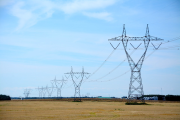The incredible boom in coalbed methane — 3,500 wells drilled by the end of 2004 and close to 7,000 by the end of 2005 — has some rural Albertans concerned about their water supplies.
Small fenced enclosures are springing up across central and southern Alberta, each protecting a wellhead and sometimes a compressor. Many of these new wells are producing coalbed methane or, to use the name favoured by the Alberta government, natural gas in coal.
This rapid growth is sparking heated debate. Some landowners welcome the rent from leasing the well sites; others are concerned about the impacts on farm operations. They are asking questions about the fragmentation of their land with wells and pipelines, the impacts on natural grasslands, and the noise from compressors and traffic. Most of all, they worry about their water.
This week, Tweeti Blanchett, a New Mexico rancher and republican activist, and Gwen Lachelt, Director of the Oil and Gas Accountability Project in Colorado, are touring Alberta, recounting the problems coalbed methane has caused for farmlands, water and the quality of life in the United States. Although the geology and regulations in Alberta differ from the United States, we must learn from their experiences to avoid making the same mistakes.
Last week, Dr. David Swann, the Official Opposition Environment Critic, drew attention to two Alberta landowners who have gas in their water wells. People are discovering problems with methane in their wells in Alberta and are very upset. The emerging viewpoint is that there is a connection between coalbed methane drilling and these problems.
In other jurisdictions, coalbed methane operations have fractured or depressurized coal seams, which enables methane to seep into water wells. Of course, methane can also come from naturally occurring natural gas reservoirs, from water wells drilled in coal seams and even from poorly maintained water wells.
However, gas is sometimes found in water wells, and Alberta needs procedures to avoid, detect and resolve the problem. By "fingerprinting" the gas (by testing its isotopic characteristics) gas from different sources can be distinguished. This should enable the source of the problem to be identified and dealt with, but landowners must trust the process. Landowners should also be compensated when coalbed methane drilling is found to be causing problems.
The Pembina Institute's book, When the Oilpatch Comes to Your Backyard: A Citizens' Guide, recommends that landowners ask a company to test their water well before they start drilling. On March 6, 2006, Alberta Environment announced that baseline testing of water wells will become mandatory before drilling coalbed methane wells. Alberta Environment also announced a program to map groundwater resources in central Alberta. This is a good start, even if long overdue.
Baseline knowledge, compiled in a public database, is essential, especially in parts of central Alberta where coal seams are shallow and contain fresh water. No drilling for coalbed methane should be allowed if it would jeopardize fresh water resources
The government's Multi-stakeholder Advisory Committee on Coalbed Methane/Natural Gas in Coal spent two years drawing up recommendations to improve the regulation of coalbed methane in Alberta and presented them to the government in February. In their preliminary findings, this committee made many proposals regarding water. If Alberta Environment is to fully implement all the committee's recommendations, it must be given sufficient funds to do so.
The Energy and Utilities Board forecasts that by 2014, 12 twelve per cent of Alberta's natural gas will come from coalbed methane, compared with about one per cent in 20051. Tens of thousands of new coalbed methane wells will be drilled. Therefore, regulations must be revised to minimize the risk of damage to fresh water aquifers or gas migration. And if problems should occur, landowners must get immediate help in finding the cause and resolving the problem.
Rural Albertans can live without coalbed methane wells, but they can't live without water.
- 30 -
Dr. Mary Griffiths is a Senior Policy Analyst with the Pembina Institute. Her book, When the Oilpatch Comes to Your Backyard: A Citizens' Guide is a complete guide to interacting with oil and gas companies and is available from the Pembina Institute at www.pembina.org.
650 words
1. EUB, ST98-2005. Alberta's Reserves 2004 and Supply/Demand Outlook, p. 4-9.







